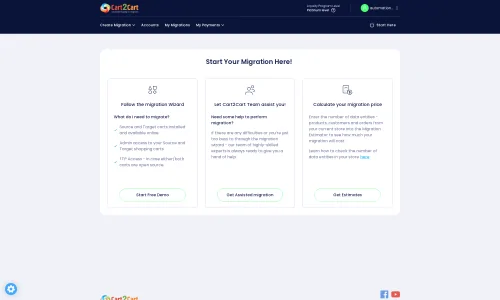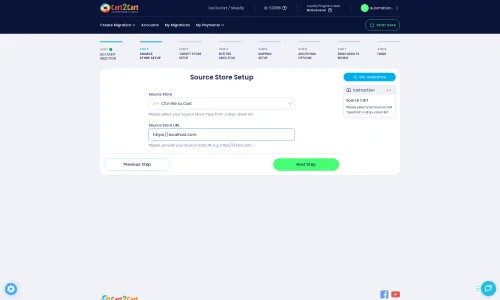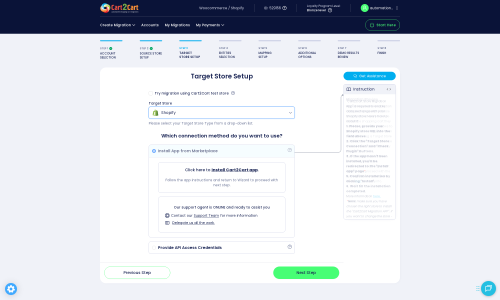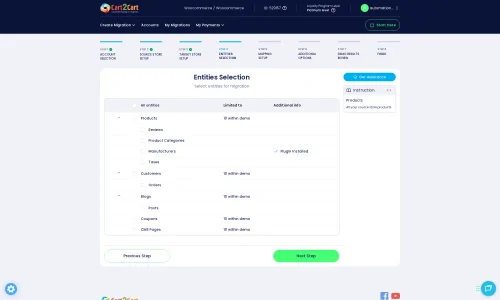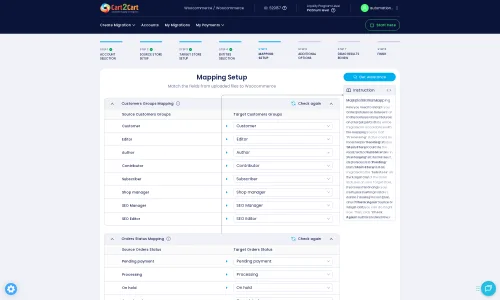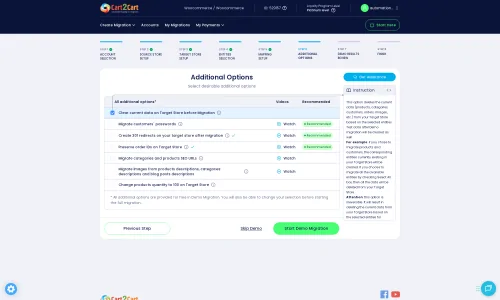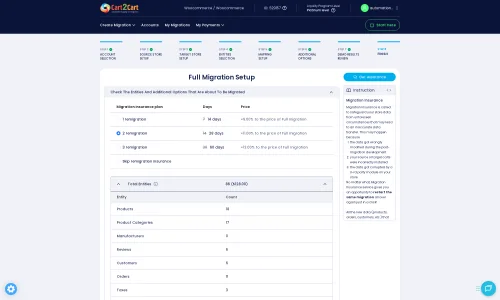Ascentium Commerce Server to Shopify Migration - Step-by-Step Guide & Expert Services
Ascentium Commerce Server to Shopify migration is seamless with Cart2Cart. Ready to move Ascentium Commerce Server store to Shopify? We ensure a fast, secure, and SEO-friendly transition with zero downtime. Whether you want to switch from Ascentium Commerce Server to Shopify yourself using our detailed guide to transfer data effortlessly, or prefer our experts to handle everything, Cart2Cart makes your Ascentium Commerce Server to Shopify migration straightforward. Elevate your online store today.
What data can be
migrated from Ascentium Commerce Server to Shopify
-
Products
-
Product Categories
-
Manufacturers
-
Customers
-
Orders
Estimate your Migration Cost
To calculate your Ascentium Commerce Server to Shopify migration price, click the button below. The migration price may vary depending on the number of data types and the additional migration options selected.
How to Migrate from Ascentium Commerce Server to Shopify In 3 Steps?
Connect your Source & Target carts
Choose Ascentium Commerce Server and Shopify from the drop-down lists & provide the stores’ URLs in the corresponding fields.
Select the data to migrate & extra options
Choose the data you want to migrate to Shopify and extra options to customise your Ascentium Commerce Server to Shopify migration.
Launch your Demo/Full migration
Run a free Demo to see how the Cart2Cart service works, and when happy - launch Full migration.
Migrate Ascentium Commerce Server to Shopify: The Ultimate 2025 Guide
A Comprehensive Guide to Transitioning from Ascentium Commerce Server to Shopify
Embarking on an e-commerce platform migration can be a pivotal moment for any online business. If you're looking to move your store from Ascentium Commerce Server to Shopify, you're making a strategic decision to embrace a more scalable, user-friendly, and feature-rich ecosystem. While Ascentium Commerce Server primarily relies on CSV file exports for data transfer, Shopify offers robust API and app-based connections, making the data migration a streamlined process with the right tools.
This guide will walk you through every essential step, ensuring a smooth and successful transition of your valuable store data, including products, customer information, orders, and more, from Ascentium Commerce Server to your new Shopify store. We'll leverage the power of a migration wizard to simplify this complex replatforming journey.
Prerequisites for Migration
Before initiating your store transfer, a few preparatory steps are crucial to ensure data integrity and minimize downtime.
For Your Ascentium Commerce Server Store (Source Store):
- Data Export: Ascentium Commerce Server typically requires you to export your store data (products, customers, orders, etc.) into CSV files. Ensure you have access to your store's admin panel to perform these exports.
- Data Review and Cleansing: Take this opportunity to review your exported CSV files. Clean up any outdated products, incorrect customer information, or irrelevant data. A clean source leads to a cleaner target store.
- Backup Your Data: Always perform a complete backup of your Ascentium Commerce Server database and files. This serves as a safety net in case of any unforeseen issues during the migration process.
- Access to Files: Ensure you can access any images, downloadable products, or other static files associated with your store, as these will need to be imported alongside your core data.
For more detailed preparation guidelines, refer to our How to prepare Source store for migration? guide.
For Your Shopify Store (Target Store):
- Shopify Store Setup: Have a new or existing Shopify store ready. You can start with a free trial or a development store. Ensure you have full administrative access.
- Install Cart2Cart App: For a seamless data transfer, you will need to install the Cart2Cart Store Migration App from the Shopify App Store. This app facilitates the connection and data import process.
- Disable Notifications: It's highly recommended to disable email notifications to customers during the migration to avoid sending confusing or premature updates about orders or account changes.
- Review Plan Limitations: Be aware that if your Shopify store is on a "Pause and Build" plan, it will block orders, which can impact testing during migration.
Find out more about preparing your new platform here: How to prepare Target store for migration?
Performing the Migration: A Step-by-Step Guide
With your prerequisites in order, let's begin the actual data transfer process using a migration wizard.
Step 1: Initiate Your Migration
Begin by accessing the migration wizard. This is your starting point for setting up the transfer between your old Ascentium Commerce Server data and your new Shopify store.
You can choose to start a DIY migration or explore our Basic Data Migration Service for guided assistance.
Step 2: Configure Your Source Store (Ascentium Commerce Server via CSV)
Since Ascentium Commerce Server is not directly integrated, you will configure your source store by uploading the CSV files you prepared.
- Select "CsvToCart" as your Source Cart from the dropdown menu.
- Upload your CSV files: The wizard will prompt you to upload the CSV files containing your products, customers, orders, and other entities from Ascentium Commerce Server.
This method ensures that all your exported data can be recognized and processed for migration. For more details on this process, visit our CSV.File Data Migration page.
Step 3: Connect Your Shopify Target Store
Next, you'll establish the connection to your Shopify store.
- Select "Shopify" as your Target Cart.
- Choose a Connection Method: The recommended method is to Install App from Marketplace. Follow the instructions to install the Cart2Cart migration app on your Shopify store. This method is generally the most secure and straightforward.
- Alternatively, you can choose to Provide API Access Credentials. This involves creating a custom app in your Shopify admin, configuring necessary API scopes, and obtaining an Admin API access token.
For detailed instructions on API credentials, read The Short & Essential Guide to Access Credentials for Cart2Cart.
Step 4: Select Data Entities for Transfer
This critical step allows you to define exactly what data you want to move from your Ascentium Commerce Server CSVs to Shopify. You can migrate a wide range of entities:
- Products: Including SKUs, variants, descriptions, images.
- Product Categories: Organizing your catalog.
- Customers: Customer data, shipping, and billing addresses.
- Orders: Order history and status (note: Shopify's "Pause and Build" plan blocks orders).
- Products Reviews: Note that on Shopify, reviews often require an additional app like AirReviews to be fully functional.
- CMS Pages: Important content like "About Us" or "Contact Us" pages.
- Blogs & Blog Posts: Preserving your content marketing efforts.
- Coupons & Price Rules: Migrating your promotional strategies.
- Other entities like Invoices, Taxes, and Manufacturers (often mapped to Shopify's "Vendor" field).
You can select all entities or pick and choose based on your specific needs.
Step 5: Map Data Fields
Data mapping ensures that information from your Ascentium Commerce Server CSVs is correctly aligned with the corresponding fields in Shopify. The wizard will guide you through mapping various fields, such as customer groups and order statuses. This is crucial for maintaining data integrity and ensuring a seamless user experience on your new platform.
Step 6: Configure Additional Migration Options
Enhance your migration with powerful extra features:
- "Clear Target Data": Opt to Clear current data on Target store before migration option to remove any demo products or placeholder data from your Shopify store prior to import.
- "Preserve Order IDs": Maintain your original order numbering from Ascentium Commerce Server. Learn more about How Preserve IDs options can be used?
- "Create 301 Redirects": Crucial for SEO, this option creates automatic redirects from your old Ascentium Commerce Server URLs to their new Shopify counterparts, preserving your SEO rankings and link equity.
- "Migrate Images in Description": Ensures all product and category images embedded within descriptions are transferred.
- "Migrate Groups to Tags": Map customer groups or product groups to Shopify's tagging system for better organization.
Step 7: Run the Demo Migration & Full Migration
Before committing to the full data transfer, perform a free demo migration. This allows you to migrate a limited number of entities (e.g., 10-20 products, customers, and orders) to your Shopify store.
- Review Demo Results: Thoroughly inspect the migrated data on Shopify to ensure everything looks correct and functions as expected. Check product details, customer accounts, and order history.
- Initiate Full Migration: Once satisfied with the demo, proceed with the full migration. The wizard will provide an estimate of the cost and duration. Consider adding a Migration Insurance Service for peace of mind, allowing for multiple remigrations if needed. You can learn more about How Migration Insurance works?
Post-Migration Steps
Your data is now on Shopify, but the journey isn't over. These crucial post-migration tasks will ensure your new store is fully operational and optimized.
- Thorough Data Verification: Double-check all migrated data on your Shopify store. Pay close attention to product prices, descriptions, images, customer accounts, and order statuses to ensure accuracy and data integrity.
- Configure DNS Settings: Update your domain's DNS records to point to your new Shopify store. This makes your new store accessible to your customers.
- Implement 301 Redirects: If you didn't create 301 redirects during the migration, set them up manually. This prevents broken links, preserves your SEO rankings, and ensures a seamless user experience for returning customers.
- Install Essential Apps: Head to the Shopify App Store to install any necessary apps. For example, if you migrated reviews, you'll need an app like AirReviews to display them correctly. Explore apps for marketing, shipping, inventory management, and more.
- Set Up Payment Gateways: Configure your preferred payment providers (e.g., Shopify Payments, PayPal, Stripe) and thoroughly test them to ensure transactions process smoothly.
- Test Shipping Settings: Verify all your shipping zones, rates, and carriers are correctly configured and functioning.
- Customer Account Activation: Inform your customers about the new store and guide them on how to activate their accounts (if passwords were not migrated or require resetting).
- Update External Links: Update any external links pointing to your old Ascentium Commerce Server store (e.g., social media profiles, email signatures, blog posts) to your new Shopify URLs.
- Monitor SEO Performance: Keep an eye on your search engine rankings and traffic using tools like Google Analytics and Google Search Console to quickly identify and address any issues.
- Consider Recent Data Migration: If your Ascentium Commerce Server store continued to receive orders or new customer registrations during the migration process, consider a Recent Data Migration Service to transfer any newly added data.
Congratulations on successfully replatforming your e-commerce store from Ascentium Commerce Server to Shopify! By following these steps, you've laid the groundwork for enhanced growth and operational efficiency on your new platform. If you encounter any challenges or require further assistance, don't hesitate to Contact Us.
Ways to perform migration from Ascentium Commerce Server to Shopify
Automated migration
Just set up the migration and choose the entities to move – the service will do the rest.
Try It Free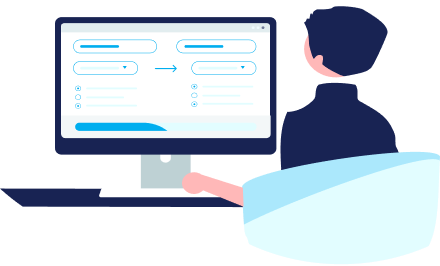
Data Migration Service Package
Delegate the job to the highly-skilled migration experts and get the job done.
Choose Package

Benefits for Store Owners

Benefits for Ecommerce Agencies
Choose all the extra migration options and get 40% off their total Price

The design and store functionality transfer is impossible due to Ascentium Commerce Server to Shopify limitations. However, you can recreate it with the help of a 3rd-party developer.
Your data is safely locked with Cart2Cart
We built in many security measures so you can safely migrate from Ascentium Commerce Server to Shopify. Check out our Security Policy
Server Security
All migrations are performed on a secure dedicated Hetzner server with restricted physical access.Application Security
HTTPS protocol and 128-bit SSL encryption are used to protect the data being exchanged.Network Security
The most up-to-date network architecture schema, firewall and access restrictions protect our system from electronic attacks.Data Access Control
Employee access to customer migration data is restricted, logged and audited.Frequently Asked Questions
How do I transfer my store design or theme from Ascentium Commerce Server to Shopify?
Can customer passwords be migrated from Ascentium Commerce Server to Shopify?
Is my Ascentium Commerce Server store data secure during the transfer to Shopify?
Will my Ascentium Commerce Server store go offline during migration to Shopify?
How can I keep SEO rankings when switching from Ascentium Commerce Server to Shopify?
How long does a data migration from Ascentium Commerce Server to Shopify take?
How can I validate data accuracy after migrating from Ascentium Commerce Server to Shopify?
What factors affect the cost of migrating from Ascentium Commerce Server to Shopify?
What data entities can be migrated from Ascentium Commerce Server to Shopify?
Should I use an automated tool or hire an expert for Ascentium Commerce Server to Shopify migration?
Why 150.000+ customers all over the globe have chosen Cart2Cart?
100% non-techie friendly
Cart2Cart is recommended by Shopify, WooCommerce, Wix, OpenCart, PrestaShop and other top ecommerce platforms.
Keep selling while migrating
The process of data transfer has no effect on the migrated store. At all.
24/7 live support
Get every bit of help right when you need it. Our live chat experts will eagerly guide you through the entire migration process.
Lightning fast migration
Just a few hours - and all your store data is moved to its new home.
Open to the customers’ needs
We’re ready to help import data from database dump, csv. file, a rare shopping cart etc.
Recommended by industry leaders
Cart2Cart is recommended by Shopify, WooCommerce, Wix, OpenCart, PrestaShop and other top ecommerce platforms.



